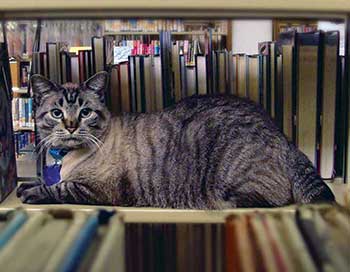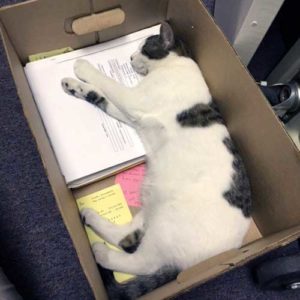
When Browser, the live-in cat of White Settlement (Tex.) Public Library, nearly got furloughed last year, public outcry was tremendous.
The city council voted to remove the popular kitty—who had lived in the library for nearly six years—after council members cited potential allergy issues. The story was picked up by ABC News, the Huffington Post, and the Associated Press; support poured in from as far away as Australia; and more than 5,000 people signed a petition to let Browser stay. In the end, the council turned tail, and Browser got to keep his job.

Though everything turned out all right for the lucky kitty, the incident illustrated just how contentious having a cat in a library can be, even when the cat is popular with patrons. Perhaps that’s why the number of library cats in the United States has declined drastically in recent decades.
About 20 years ago, filmmaker Gary Roma researched library cats all over the world for his documentary Puss in Books: Adventures of the Library Cat. At that time, he counted 201 cats living in American libraries. In autumn 2016, inquiries made through the heads of each ALA state chapter yielded a count of 39 library cats across the country.
One of those cats is Pages, a black-and-white female who began her tenure at the Valley Center (Kans.) Public Library six years ago after being found as a kitten under a bush outside. Pages has access to the entire library but prefers to hang out in the foyer; when she gets tired of being petted by her fans, she retreats to a book cart for some downtime.
“The board has been supportive, and for the most part, people have been very agreeable,” says Library Director Janice Sharp. “She’s created excellent goodwill. Patrons obviously like her.”
In an attempt to minimize the allergens present on library materials, staff members swipe each book with a Clorox wipe. Still, Sharp knows patron allergies are an ever-present concern.
“From time to time we do hear complaints,” she says. “We tell them that we’re sorry they’re affected, and if people cannot come in the library [because of the cat], we offer to select books for them and take them out to their car.”
Allergies have not been much of a problem at Litchfield (Ill.) Public Library, home of Stacks the cat, says Library Director Sara Zumwalt. Stacks is thought to be the only library cat in the state allowed access to patron areas. “She goes wherever she wants and sits wherever she wants,” Zumwalt says. “She likes to greet people when they come in, and she likes to ride the elevators.”

Before adopting Stacks in 2009, Zumwalt consulted local veterinarians about allergies. “They said that as long as we kept the hair vacuumed, we really shouldn’t have any problems,” she says. “We have a good janitor, and our building has hot-water heating and cooling, so we don’t have any air that recirculates and blows the hair around. We really haven’t had a lot of allergy complaints. I have more people who say, ‘I’m allergic to the cat—but I love her, and I have to hold her.’ ”
Like most library cats, Stacks generates tremendous press for her surroundings. She’s appeared in Cat Fancy and the Chicago Tribune, and more than once, Zumwalt has introduced herself at a library conference, only to hear: “Oh, you’re the library with the cat!”
“I think everybody thinks of her as their cat,” Zumwalt says. “I think people enjoy having that connection.” That said, “we’ve been very lucky that we haven’t had anyone who’s said, ‘You can’t have her here.’ ”
The Colon Township (Mich.) Library wasn’t so fortunate with its former resident cat, Jasper. “Everybody loved Jasper,” says Library Director Julie Censke. “He was always on a lap or busy getting petted. But we had a family who caused a big fuss because a family member was allergic. I wrote them a letter and offered to bring them their books, and we got a high-powered air filtration system, but they didn’t want to entertain those ideas. Eventually they contacted the Michigan Department of Civil Rights. The board didn’t have the money to handle lawyer fees, so they sent Jasper away. He’s been at my house ever since.”
Some libraries compromise by having resident cats who are allowed in staff areas only. At LaGrange County (Ind.) Public Library, for example, Emma the calico enjoys free rein of the staff offices. “That gives her plenty of room. We don’t put her out in the public area; there are lots of people with allergies,” says Library Director Richard Kuster. “Giving her the run of the library was not anything that anybody was going to permit, given the potential public backlash.” This way the staff, at least, can enjoy the calming effects of Emma’s presence (when she’s not walking across one of their computer keyboards).
Other cat-loving libraries are skirting the allergy issue by finding alternate ways to include kitties in their PR efforts. The Centre County (Pa.) Library and Historical Museum doesn’t have a cat on its premises at all; instead, librarian Lisa Shaffer includes photos of her five cats in the library’s Saturday Twitter and Facebook posts. Each “Saturday Caturday” post features one or more of her cats posing with a book and often wearing an accompanying costume. One post celebrating Shakespeare’s birthday, for example, saw orange tabbies Marmie and Horatio flanking a copy of Will in the World: How Shakespeare Became Shakespeare while sporting fetching Elizabethan ruffs fashioned from coffee filters.
Frannie Shue, Centre County library director, is a big fan of “Saturday Caturday,” saying, “It’s a nice alternative for libraries that do not have cats—but love cats as much as books.”

















As usual, the issue with cats is not understood. The allergen is not their hair, it’s their SKIN aka dandruff. And it’s not about just being in an area with the animal, it’s also touching anything the cat has touched. It’s easy to see hair and clean it. It doesn’t matter if you Lysol the books, the skin falls in the pages. And while cats are cute and probably take care of any library mice, the issue involves accessibility to the entire community. Cat allergies are extremely common, and the institution of library cats is ostracizing people. Libraries are a public institution, not a business you may choose to patron. I look above to see articles about ‘Bringing Assistive Technology to Patrons’ and ‘Promoting Access for Blind and Visually Impaired Patrons’. According to the U.S. Census, 14% of the population have vision issues, 0.4% are blind, 0.38% are deaf, but 10% of the population is allergic to cats. We go out of our way to help those with special needs, and we should, but ignore those with a possible deadly condition in the name of having a mascot. We are excluding 10% of the population who help fund libraries and deserve the ability to use the resource they helped pay for, in the name of something cute. If we went out of our way to exclude those with other problems, libraries would rightly be vilified. Just get a stuffed cat and everyone can visit. At least they can be washed.
I am allergic to cats, but have two at home, as I love them so. I have tried to have our public library–The Boston Public Library–and our subscription library–The Boston Athenaeum (which allows visiting dogs {the director brings her dog} but not cats)–include cats in their collections. But, it seems that some people claim they will drop dead from cat allergies, or worse, they will get pissy and complain bitterly to the Board of Trustees about the cats (they can’t help themselves so I don’t blame them–getting pissy is an allergic reaction says my cat’s vet). I have suggested cat-free rooms in the libraries, and have even offered up my own book collection for people to check out, but none of my suggestions seem acceptable. If ten percent of the population is allergic to cats then that is a lot. I wonder, however, what percentage of that ten percent actually use libraries and read books given that most of the population is allergic to reading. Oh, speaking of allergies, we do have a person who is allergic to touching paper so we supply gloves. Also, both libraries have very active children’s literacy programs so if anyone fears cold or flu germs then I suggest you stay out of the children’s collections (and wash your hands often)(or just ban children). And there are theories that traces of the Spanish influenza (which killed about 20 million people world wide) and perhaps even traces of the great plagues can be summoned up from parchment which has been coughed upon and spit on and licked by dying readers. I think if I were so allergic to cats that I’d stay home, in a bubble, and just order the books digitally from the greatest cat free library in the world–Amazon.
Well said! I like how you put that, it’s unfortunate people always find something to complain about and create issues.
I’m a librarian and love reading books. I like cats but I have asthma and they are one of my biggest triggers, in addition to having allergies to them. I could quite literally drop dead from being around one. But if you wish to put a cat above my life, so be it. I just would hope most people would not feel that way.
I agree with you completely.
It’s about public use. Government buildings are supposed to be able to be used by every citizen. That’s why we provide access for all. It’s about equality.
I agree with you but as I understand it, the allergen is in their spit. The reason it gets on their fur is because they lick themselves all the time.
Thank you. I wish people understood that it’s not about being mean spirited. It’s about a preventable allergens. But it’s not just the spit on the fur, it is also dandruff. The person who owned my house twenty years ago had a cat. All the hair was gone, but we still had to remove all the carpets and wash every surface several times before it was livable.
I grow so weary of mean-spirited people always trying to find something to complain about and the oh-so-dramatic assertions that cat allergies are lethal. Yes, a very few people may have that severe an allergy (and hopefully they carry epi-pens), but most people are just complaining for the sake of being able to have power over others. I have cats at home and their hair and dander gets on my clothes. Should I go through decontamination every time I step outside my house so that I don’t affect anyone in the world? Should I be banned from the library because my cats will contaminate the books if I check them out and bring them home with me? I’m allergic to cats and dogs, but no one seems to be concerned that reading dogs make me itch and service animals set off my allergies. I learned a long time ago that I share this planet with other species, and to deal with it.
I like cats but I have asthma and they are one of my biggest triggers, in addition to having allergies to them. I could quite literally drop dead from being around one. I’m not “mean spirited”, that’s just the reality of the situation. For some people it can be lethal. Wouldn’t it be better to be safe rather than sorry? Especially in a tax payer supported space that is supposed to be open and welcoming to all?
Pets are considered a preventable allergen. Many insurance companies won’t pay for Epi-pens for animal allergies.
I feel there is a lot of misinformation in this article. Cat dander is sticky. It sticks to walls, carpets, etc. Vacumning can often make things worse. It has nothing to do with the hair. Perhaps consulting an allergist not a veterinarian would offer more accurate information. I work in a library and I’m allergic to cats. There is no way I could tolerate that and feel healthy. My son is more allergic than I am. At one point his Montessori preschool “adopted” a cat. My son was a mess! He was wheezing and rubbing his eyes. I had to take him out of school until the cat was removed. It’s a very serious issue that’s not about being grumpy or not liking cats.
I’m a librarian and love reading books. I like cats but I have asthma and they are one of my biggest triggers, in addition to having allergies to them. I could quite literally drop dead from being around one. A public library is supported by tax dollars and is supposed to be open and welcoming to all, I shouldn’t have to put my life at risk to go into one. It seems like a no brainer to me but it seems like the only people who really get this issue are the people who have allergies or asthma and know the risks firsthand.
As a public space there is no control over what allergen is brought into and left in the library from people’s clothing.
Library items go home to who knows what, and come back with who knows what on them.
Not all public libraries are supported by tax dollars.
I would hardly say a cat is a mascot. Pet therapy is extremely beneficial. Those allergy sufferers who pet the cat anyway are getting this benefit. My employer pays for Pet Therapy visits a few times a year.
Keeping the library clean is extremely important if any animals live or visit the library.
In more populated places there are many libraries to choose from, in a city/town/region, and very few libraries with cats/pets.
However, in less populated places where the next library is not very close by, it could be an issue.
A taxpayer wanting to use their own public library is great! Allergy sufferers can certainly facilitate a change at their library. Hopefully they will do it with courtesy and respect, and hopefully the library/board responds with courtesy and respect.
A questionnaire for town residents and library patrons of libraries who Do and Do Not have a cat/pet:
Would you stop coming to the library (or reduce visit frequency) if a cat came to reside in the library?
Would you be more likely to come to the library if a cat resided in the library?
Would you stop coming to the library (or reduce visit frequency) if the resident cat was no longer at the library?
I would not patronize a library with any animal that roamed free in the facility.
People who love cats are ferocious in their dedication and totally lacking in understanding of people who do not. Not only am I severely allergic to cats but I also have an unhealthy fear of cats. I will not willingly enter any space where there is a cat. My allergic reaction mimics the flu and I have no desire to experience that. What if a cute little snake had been found on the library grounds, would the snake be adopted and allowed to roam the stacks since it would also be eating the mice? I am a school library media specialist and, in my effort to maintain a healthy environment in the media center, keep the wipes, tissues and sanitizers available for my use and my patrons’ convenience (at my own expense). I would be one of those pissy complaining patrons if I saw a cat inside of my neighborhood library.
I work in a library. I’ve worked in libraries for over twenty years. I’m extremely allergic to cats. Just being in a house (or room where a cat spends a lot of time) can make my eyes water uncontrollably and swell shut; this has happened within 15 minutes of being exposed to cat dander. I’ve also had a couple of very scary experiences where I started wheezing and experienced labored breathing due to cat dander. I can’t imagine being subjected to this in my work environment on a daily basis should my library decide to adopt a cat. It would be intolerable and would cause me to seriously consider resigning and looking for a position in another library. If I were a patron I would not be able to visit my public library if they decided to adopt a cat. I can’t visit our local independent bookstore for this reason (the owner has two cats).
Because some people want attention and sympathy and enjoy ruining things for everybody else.
Similarly, I think we need to consider those who are allergic to Wifi. It’s THEIR RIGHT to be able to go into public buildings (like libraries) without being discriminated against due to their disability (allergy).